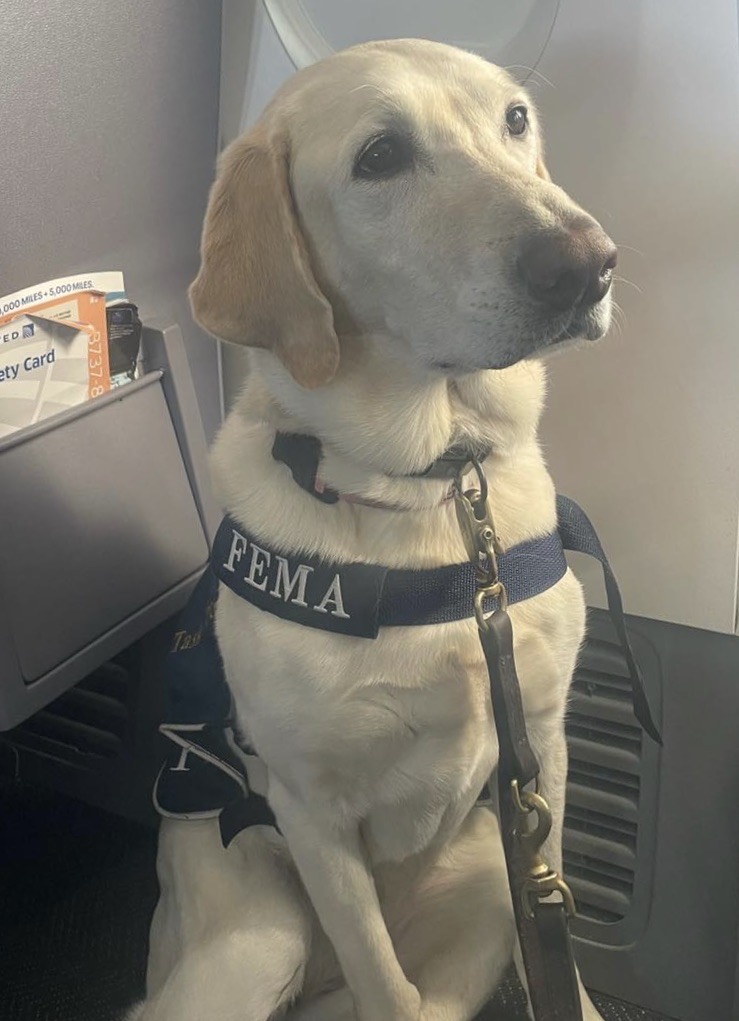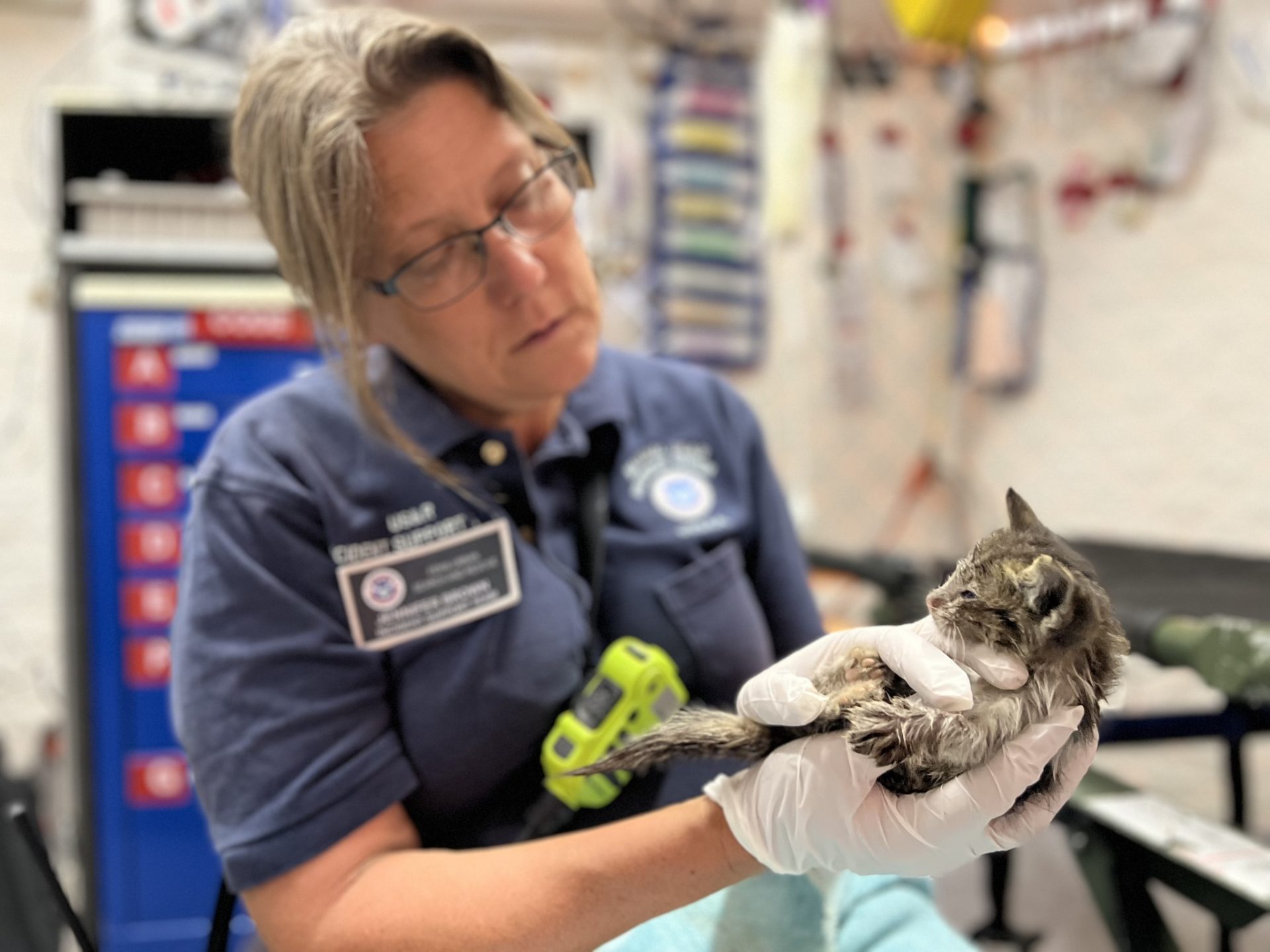LANSING, Mich. (Michigan News Source) – Helping with the grim task of locating bodies in the burnt-out areas of Lahaina on the island of Maui are 35 Canine Search Specialist Teams, each consisting of one handler and one dog who are part of Task Force teams from all over the United States. These are nationally certified Human Remains Detection (HRD) Canine Search Teams who are part of the National Urban Search & Rescue (US&R) Response System, established under the authority of FEMA in 1989.
MORE NEWS: Congressman Jack Bergman Asks Trump to Send Recently Arrested Illegal Alien to Guantanamo
According to FEMA, “Canine search teams play a critical role in supporting local and state response efforts with the capability to locate disaster survivors and human remains using canine teams.” These teams are equipped and ready to deploy within six hours of activation. Although the Task Force teams are set up on a rotation basis to respond when needed, there is also the issue of which teams are the closest to the disaster area and can get there the fastest.
The National US&R Response System reports that canines and handlers went to Maui from all over the country to assist with the search operation. The U.S. Department of Homeland Security’s FEMA Urban Search & Rescue has a list of 80 nationally certified human remains detection canine search teams, with some of the handlers having more than one canine that they are teamed up with. The teams are assigned with one of 28 Task Forces across the United States that are set up in California, Colorado, Florida, Indiana, Massachusetts, Maryland, Missouri, Nebraska, New Jersey, Nevada, New York, Ohio, Pennsylvania, Tennessee, Texas, Utah, Virginia and Washington.
Among the 35 canine teams in Maui is CSS (Canine Search Specialist) Kim Veldheer and HRD Major, a yellow Labrador Retriever. Kim is from Rives Junction, Michigan about 30 minutes southeast of Lansing. Veldheer is in Maui with two other canine teams from Ohio Task Force 1 (OH-TF1). The other teams include CSS Heather Fergusson with HDR canine Melvin, a Belgian Malinois and CSS Nick Fathergill with HRD Sunny, a Labrador retriever (pictured).

Michigan News Source reached out to Chris O’Connor, Public Information Officer with OH-TF1, to find out more about the Rives Junction team and we learned that Veldheer has been with the Ohio Task Force since February of 2016. Major was just certified this spring and this is his first activation.
O’Connor describes Veldheer as a “phenomenal handler,” calling her a very helpful member of the team during training and very encouraging. She said Major is an adorable dog with a lot of energy but is very driven and focused. So far in Maui, Veldheer and Major have searched residential and commercial structures as well as vehicles. O’Connor says a team can end up searching 50 or more structures a day. Depending on whether the search assignment is for a house, a business or an apartment building, everything poses a different kind of challenge including sometimes getting delayed waiting on heavy equipment to move things before a team can search.
Veldheer is no stranger to search and rescue – or search and recovery. In 2020, Veldheer was deployed to Louisiana with OH-TF1 in response to Hurricane Delta and over the years, Veldheer and her dogs and been involved in many search operations including as a volunteer with K-9 One Search and Rescue, a volunteer organization of specially trained canine handlers dedicated to search and rescue work. Along with her canine partner at the time, Tigger, they were able to find several lost Alzheimer’s patients and also locate missing persons including murdered Janna Kelly in Grand Rapids.
During the OH-TF1 team’s flight to Hawaii, the canines were required to sit on their human partner’s lap for hours. A Facebook post from the Ohio Task Force 1 about the flight from Chicago to San Francisco read, “As the flight landed, the crew requested passengers remain seated and allow the canine teams to exit first. Every passenger remained in their seats and many applauded as the teams exited the plane, humbled by the kindness.”
MORE NEWS: Swan Song: Festival of the Arts in Grand Rapids Ending After 55 Years
O’Connor says that the activation of a team can last a couple days to a couple weeks. She also said, “We are there until the job is done with no timeline in mind.”
Fox 8 in Ohio reports that Ohio Task Force 1 Leader Jim O’Connor said about the canines, “They’ll be assisting with the search efforts in that burned area where sometimes it’s hard to locate, hard for us to see with the eyes, but the canines with their sense of smell are able to detect things that we’re unable to locate.” He continued, “Dealing with the intense heat will be very challenging for both the canines and the handlers. The heat in Hawaii, the heat from the fire that’s still there where the ground is still warm – they’re dealing with some very hot temperatures just on the blacktop and stuff – so we have to have extra boots for the canines to be able to protect their feet, so that they can do the tasks we’re asking of them.”
According to Chris O’Connor, the 35 Canine Specialist Teams that are activated in the Lahaina area, are embedded with five Task Force Teams. Four of the teams are Type 1 and include the Task Force teams from Washington, California, Indiana and Maryland. Type 1 is the highest qualification level and these teams can operate for 24-hour periods. The other task force is from Nevada and is activated as a Type III team which means they can operate for 12-hour periods with shifts determined by the Task Force Leader and Incident Commander. Major and handler Veldheer have been mostly assigned with Nevada Task Force 1 and Washington Task Force 1 – but the assignments of a team can change from day-to-day depending on what is needed.
The five Task Force teams described above are full teams that include all of the components of leadership. O’Connor said that’s how OH-TF1 is frequently deployed. She said, “Our team would typically have task force leadership, communications and planning teams that would allow them to be self contained. They would bring their own equipment, direct and support their operations (including food and sleeping arrangements), and manage their own team members. In this instance, we were asked just to deploy three CSS members and three HRD canines. Because of this, our Canine Search Teams have been assigned to one of three squads, supervised by a Search Team Manager from one of the Type I or Type III teams.”
Other areas of the country have canine teams who were deployed similarly including Texas, Florida and Pennsylvania who were then integrated into other full Task Force teams. O’Connor said, “So typically what’s happening here is that they are being assigned to the larger teams that are there.” Washington and Nevada, who were close by to Maui, were activated and first out the door.
It’s unknown if any more canine teams will be needed to be sent to Maui but O’Connor said that it’s possible that some of the dogs already there might have to be replaced if a handler or a canine gets injured or if a canine becomes tired or ineffective after being there a few weeks. She said, “Our handlers are trained to watch the dogs on a daily basis and make sure that they’re healthy and performing at their best.”
Daily Operations briefings are held every morning to review mission objectives and assign tasks/missions to the Task Forces. These meetings are directed by the FEMA Incident Support Team (IST) and attended by each Task Force’s Leadership, ESF 13 personnel (Emergency Support Function #13 – Public Safety and Security Annex), CERFP (CBRNE Enhanced Response Force Package) personnel, Maui Police Department and Maui Fire Department. The partnerships made have been invaluable to their daily search operations.
With an estimated 850+ people still missing according to the Mayor of Maui, FEMA needs all the help they can get to cover the massive search area and the canine teams are providing that help with hard work and a wagging tail. A video of a canine search team in action can be seen here. To learn more about how the canine teams are operating in the adverse conditions on the island, you can also click here.
A FEMA Incident Support Team (IST) Veterinarian is also on site to help support any needs the canine teams may have day or night. According to the National US&R Response System, Dr. Jennifer Brown is that person. Her primary responsibility is the care and support of search and rescue canines. The National US&R Response System Facebook post says, “Dr. Brown has been an invaluable expert supporting canine needs in Lahaina, including decontamination procedures, foot care, overall animal wellness, and the resuscitation and transport of animals encountered in the Lahaina area. Rescue teams search for and identify animals and provide water and food for animals that may still be in the area and work with local animal control to transport the animals to more advanced care. Dr. Brown, as part of the medical contingent, has the capability to support and provide initial care and resuscitation in the impact area.”

According to the social media post, a kitten was found by the Washington Task Force team and they notified Dr. Brown they had found it alone hiding in a chicken coop. They made arrangements to meet Dr. Brown immediately as they gently picked up the kitten to took it to meet up with the doctor. Dr. Brown brought the kitten back to the medical station to examine it (pictured) and she started treatment until she could transfer care to Animal Control. Within the hour, Animal Control had the kitten in their care. Dr. Brown has treated and transferred care to Animal Control for three cats and one kitten thus far.
With the scope of the death and destruction that took place on the island and with the current grim and daunting task of searching for human remains going on, every life saved is a true miracle.

Leave a Comment
COMMENTS POLICY: We have no tolerance for messages of violence, racism, vulgarity, obscenity or other such discourteous behavior. Thank you for contributing to a respectful and useful online dialogue.